Beelitz
Beelitz is a historic town in Potsdam-Mittelmark district, in Brandenburg, Germany. It is chiefly known for its cultivation of white asparagus (Beelitzer Spargel).
Beelitz | |
|---|---|
 Coat of arms | |
Location of Beelitz within Potsdam-Mittelmark district 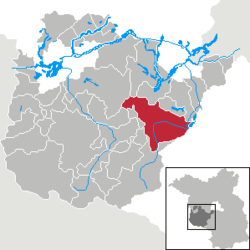 | |
 Beelitz  Beelitz | |
| Coordinates: 52°14′N 12°58′E | |
| Country | Germany |
| State | Brandenburg |
| District | Potsdam-Mittelmark |
| Subdivisions | 12 Ortsteile |
| Government | |
| • Mayor | Bernhard Knuth (BBB) |
| Area | |
| • Total | 180.08 km2 (69.53 sq mi) |
| Elevation | 40 m (130 ft) |
| Population (2018-12-31)[1] | |
| • Total | 12,448 |
| • Density | 69/km2 (180/sq mi) |
| Time zone | CET/CEST (UTC+1/+2) |
| Postal codes | 14547 |
| Dialling codes | 033204 |
| Vehicle registration | PM |
| Website | www.beelitz.de |
Geography
Beelitz is situated about 18 km (11 mi) south of Potsdam, on the rim of the Zauche glacial sandur plain. The town is surrounded by extended pine woods of the Nuthe-Nieplitz Nature Park.
Located on an old trade route from Berlin to Leipzig, today the Bundesstraße 2, it also has access to the Bundesautobahn 9 at the Beelitz-Heilstätten and Beelitz junctions. Train service to Potsdam and Berlin via the Berlin-Blankenheim railway line is available at Beelitz Stadt and Beelitz-Heilstätten stations.
History
A 997 deed by Emperor Otto III mentions a settlement with the Slavic name Belizi, though this denotation may also refer to the nearby town of Belzig.
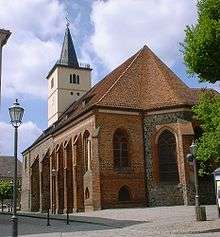
The Saint Mary and Saint Nicholas parish church was first mentioned in a 1247 report of a Jewish host desecration, and bleeding host miracle, that made Beelitz a medieval pilgrimage site. Since 1370 the host was kept in a small chapel adjacent to the church.[2][3] The reason for the former name of the Judenberg (renamed Friedensberg after 1945) before the Mühlentor is not confirmed, though tradition indicates it was the site of the burning of Jews.[4]
When in 1731 King Frederick William I of Prussia billeted a hussar regiment, Beelitz became a garrison town and today is home to a Bundeswehr command. The cultivation of asparagus was first documented in 1861.
The village of Kanin, a subdivision of Beelitz since 2001, had been an exclave of the Electorate of Saxony until 1815 and therefore a notorious smuggling area as well as a destination for deserters from the Prussian army. Its fieldstone church was erected about 1138 and today is the oldest preserved one within the Brandenburg state.
In 1928, the Telefunken company erected a radio station in the subdivision of Schönefeld for the wireless communication with North America. Together with the Nauen Transmitter Station, it was incorporated by the Reichspost in 1932. After World War II, the station was used by the Deutsche Post of the GDR until it finally went out of service in 1991.
Demography
 Development of population since 1875 within the current Boundaries (Blue Line: Population; Dotted Line: Comparison to Population development in Brandenburg state; Grey Background: Time of Nazi Germany; Red Background: Time of communist East Germany)
Development of population since 1875 within the current Boundaries (Blue Line: Population; Dotted Line: Comparison to Population development in Brandenburg state; Grey Background: Time of Nazi Germany; Red Background: Time of communist East Germany)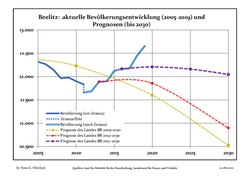 Recent Population Development and Projections (Population Development before Census 2011 (blue line); Recent Population Development according to the Census in Germany in 2011 (blue bordered line); Official projections for 2005-2030 (yellow line); for 2014-2030 (red line); for 2017-2030 (scarlet line)
Recent Population Development and Projections (Population Development before Census 2011 (blue line); Recent Population Development according to the Census in Germany in 2011 (blue bordered line); Official projections for 2005-2030 (yellow line); for 2014-2030 (red line); for 2017-2030 (scarlet line)
|
|
|
Beelitz-Heilstätten
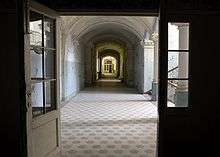
Beelitz-Heilstätten (52°15′37″N 12°55′30″E), a district of the town, is home to a large hospital complex of about 60 buildings including a cogeneration plant erected from 1898 on according to plans of architect Heino Schmieden. Originally designed as a sanatorium by the Berlin workers' health insurance corporation, the complex from the beginning of World War I on was a military hospital of the Imperial German Army. During October and November 1916, Adolf Hitler recuperated at Beelitz-Heilstätten after being wounded in the leg at the Battle of the Somme.
In 1945, Beelitz-Heilstätten was occupied by Red Army forces, and the complex remained a Soviet military hospital until 1995, well after the German reunification. In December 1990, Erich Honecker was admitted to Beelitz-Heilstätten after being forced to resign as the head of the East German government.
Following the Soviet withdrawal, attempts were made to privatize the complex, but they were not entirely successful. Some sections of the hospital remain in operation as a neurological rehabilitation center and as a center for research and care for victims of Parkinson's disease. The remainder of the complex, including the surgery, the psychiatric ward, and a rifle range, was abandoned in 1994. As of 2007, none of the abandoned hospital buildings or the surrounding area were secured, giving the area the feel of a ghost town.
In popular culture
This has made Beelitz-Heilstätten a destination for curious visitors and a film set for films like The Pianist in 2002, the Rammstein music video[6] "Mein Herz brennt", and the films Valkyrie in 2008, Men & Chicken in 2015 and A Cure for Wellness in 2016.
Beelitz-Heilstätten is a popular location for urban exploration, providing a suitably eerie photographic subject for artistic photography.[7]
- Former sanatorium for consumptives
 Pavilion B II
Pavilion B II Surgery Pavilion
Surgery Pavilion Surgery Pavilion
Surgery Pavilion Kitchen
Kitchen Washhouse
Washhouse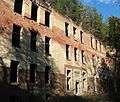 Pavilion B IV
Pavilion B IV Pavilion B IV
Pavilion B IV Pavilion B IV
Pavilion B IV
International relations
Beelitz is twinned with:
- Ratingen, North Rhine-Westphalia since 1990
- Alfter, North Rhine-Westphalia
Personalities
Sons and daughters of the city
- Götz Dieter Plage (1936–1993), nature film maker
- Falko Steinke (de) (born 1985), volleyball player
People connected to the city
- Sally Bein (1881-after June 1, 1942), teacher, head of the Jewish home for deaf children
- Wolfgang Schmidt (born 1966), serial killer, also known as Rosa Riese
See also
References
- "Bevölkerung im Land Brandenburg nach amtsfreien Gemeinden, Ämtern und Gemeinden 31. Dezember 2018". Amt für Statistik Berlin-Brandenburg (in German). July 2019.
- Das Wunderblut von Beelitz p12 Dieter Hoffmann-Axthelm - 2009 "... ab dem ein solches Wunder möglich war und für Beelitz wahrscheinlich zu machen ist. Bis heute wird in jeder katholischen Kirche die im verschlossenen Gefäß auf dem Altar anwesende Hostie als Allerheiligstes, sanctissimum, verehrt, ..."
- Der gelbe Fleck Rosemarie Schuder, Rudolf Hirsch - 1988 "Beelitz In den deutschsprachigen Gebieten war es das Städtchen Beelitz bei Berlin, in dem ein Wunder geschehen mußte. Um 1247 begann dort in der Kirche eine Hostie zu bluten. Die Stadt war eine Gründung deutscher Kaufleute, ...In unzähligen Schriften über das Wunderblut von Beelitz wurde nun der Frevel den Juden zugeschrieben. Der Hügel, den die Beelitzer den Judenberg nannten, heißt seit dem Ende des zweiten Weltkriegs Friedensberg. "
- Germania judaica: Von 1238 bis zur Mitte des 14. Jahrhunderts Zvi Avneri, Marcus Brann, Ismar Elbogen - 1968 "erschrockenen Juden gaben die Hostie der Magd zurück und bestachen sie, damit sie schweige und die Hostie unter dem Dach ihrer ... Ob der bei Beelitz vor dem Mühlentor gelegene „Judenberg" seinen Namen von einer Judenverbrennung hat, für die sonst keine Nachrichten vorhanden sind, läßt sich nicht sagen, zumal auch andere Erklärungen gegeben werden, die mit Juden ..."
- Detailed data sources are to be found in the Wikimedia Commons.Population Projection Brandenburg at Wikimedia Commons
- http://www.rammstein.de/en/news/single-vo-video-premiere-mein-herz-brennt/%5B%5D
- "Urban Exploration photographs of the abandoned Beelitz Heilstätten". Obsidian Urbex Photography.
External links
| Wikimedia Commons has media related to Beelitz-Heilstätten. |
- History, maps, and photos of the buildings early 2008 (English)
- Neurologische Rehabilitationsklinik Beelitz-Heilstätten (in German)
- Photo gallery of the abandoned hospital buildings (in German)
- The Abandoned Hospital (gallery and history) (in Polish)
- Urban Exploration report of Beelitz-Heilstätten (photo gallery and history) (in English)